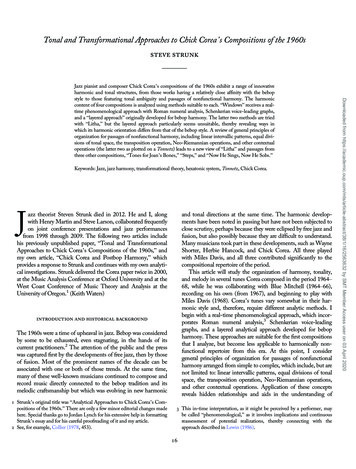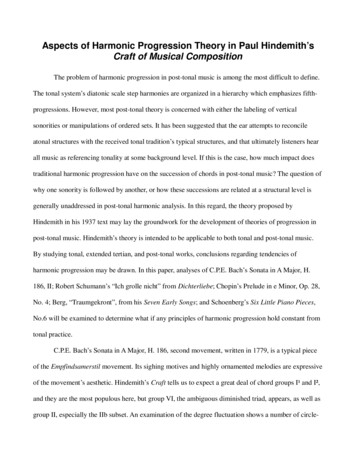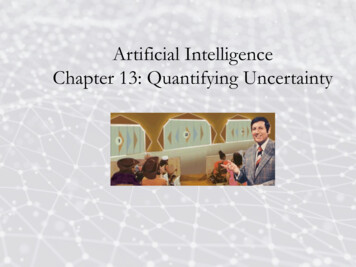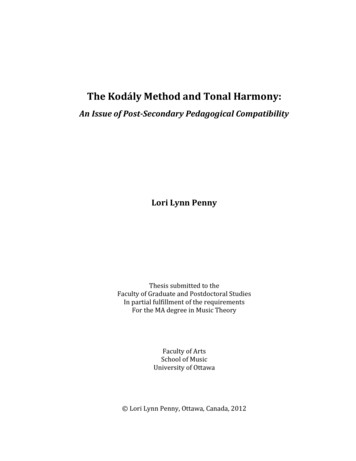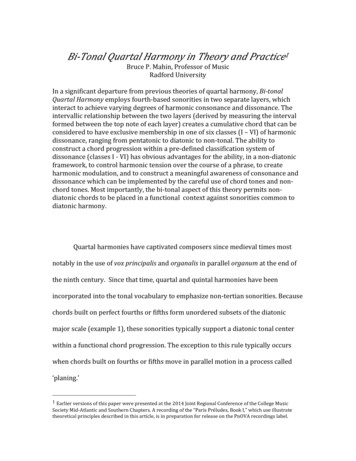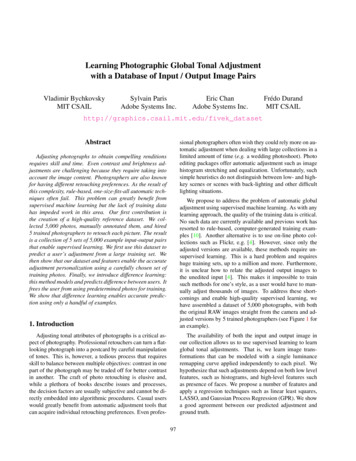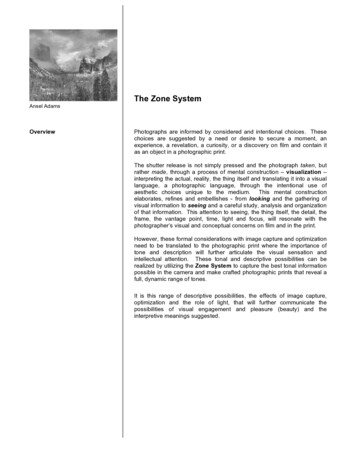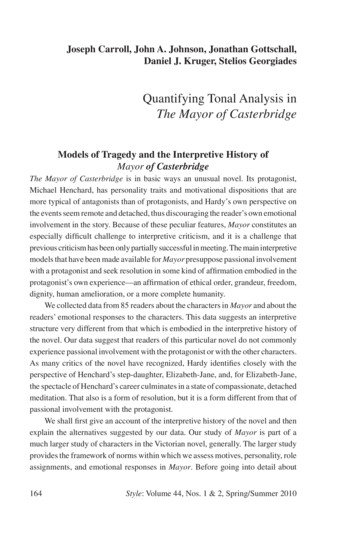
Transcription
Joseph Carroll, John A. Johnson, Jonathan Gottschall,Daniel J. Kruger, Stelios GeorgiadesQuantifying Tonal Analysis inThe Mayor of CasterbridgeModels of Tragedy and the Interpretive History ofMayor of CasterbridgeThe Mayor of Casterbridge is in basic ways an unusual novel. Its protagonist,Michael Henchard, has personality traits and motivational dispositions that aremore typical of antagonists than of protagonists, and Hardy’s own perspective onthe events seem remote and detached, thus discouraging the reader’s own emotionalinvolvement in the story. Because of these peculiar features, Mayor constitutes anespecially difficult challenge to interpretive criticism, and it is a challenge thatprevious criticism has been only partially successful in meeting. The main interpretivemodels that have been made available for Mayor presuppose passional involvementwith a protagonist and seek resolution in some kind of affirmation embodied in theprotagonist’s own experience—an affirmation of ethical order, grandeur, freedom,dignity, human amelioration, or a more complete humanity.We collected data from 85 readers about the characters in Mayor and about thereaders’ emotional responses to the characters. This data suggests an interpretivestructure very different from that which is embodied in the interpretive history ofthe novel. Our data suggest that readers of this particular novel do not commonlyexperience passional involvement with the protagonist or with the other characters.As many critics of the novel have recognized, Hardy identifies closely with theperspective of Henchard’s step-daughter, Elizabeth-Jane, and, for Elizabeth-Jane,the spectacle of Henchard’s career culminates in a state of compassionate, detachedmeditation. That also is a form of resolution, but it is a form different from that ofpassional involvement with the protagonist.We shall first give an account of the interpretive history of the novel and thenexplain the alternatives suggested by our data. Our study of Mayor is part of amuch larger study of characters in the Victorian novel, generally. The larger studyprovides the framework of norms within which we assess motives, personality, roleassignments, and emotional responses in Mayor. Before going into detail about164Style: Volume 44, Nos. 1 & 2, Spring/Summer 2010
Quantifying Tonal Analysis in The Mayor of Casterbridge165Mayor, we shall, therefore, explain the design of this larger study and the resultswe received from it.To give the reader an adequate orientation to references in the interpretive historyof the novel, we shall begin by concisely summarizing the plot. The actions in theplot of Mayor are like a roller coaster ride of wildly changing fortunes—especiallythe fortunes of Henchard, Susan, and Lucetta. In the opening chapter, Henchard is21 years old. Embittered at being held back and burdened by family responsibilities,he gets drunk at a country fair and sells his wife and baby daughter. Within the nexttwenty years, he becomes a wealthy and respected corn merchant and is electedmayor of the market town Casterbridge. Meanwhile, his wife, Susan, has livedwith Newson, the man who bought her. Her child from the marriage with Henchardhas died, but she has had another child with Newson. Both children are namedElizabeth-Jane. Newson is lost at sea, and Susan returns to Henchard, deceivinghim by telling him that Newson’s child, now grown, is his child. He remarries her,but she dies soon after. Shortly after her death, Henchard tells Elizabeth-Jane thatshe is his daughter and asks her to take his name, but, almost immediately afterthat, he discovers that Elizabeth-Jane is not, in fact, his daughter. He does not tellher that he had been deceived in believing himself her father, but he becomes coldand hostile toward her. Since her arrival in Casterbridge, Elizabeth-Jane has beenromantically interested in Henchard’s young protégé, Farfrae, who had come toCasterbridge without place or prospect, but Farfrae loses interest in ElizabethJane and takes up instead with Lucetta, who previously, unbeknownst to him,was Henchard’s mistress. Henchard began his relationship with Farfrae by beingoverbearingly friendly, but he becomes jealous of Farfrae’s popularity. Henchardbecomes bitterly antagonistic to Farfrae, and they become competitors in business.After Susan’s death, Henchard also becomes Farfrae’s rival for Lucetta, and herpreference for Farfrae embitters Henchard still further. Farfrae and Lucetta marry.In the period of just a few years after Susan’s return, Henchard’s fortunes havedeclined drastically, and Farfrae’s fortunes have steadily risen. Henchard eventuallyloses both his wealth and his social position and is compelled to work as a lowlyemployee for Farfrae, who now dominates the corn trade and also becomes the newmayor of Casterbridge. Henchard attempts to kill Farfrae by throwing him out of ahay loft but relents and breaks down in remorse. Lucetta has become pregnant withFarfrae’s child, but her past with Henchard is made public. She becomes hysterical,has a seizure, and dies through complications with the pregnancy. Having lost hisworldly position, Henchard seeks solace in establishing a bond with ElizabethJane. They live together companionably for a while, but Elizabeth-Jane secretly
166Joseph Carroll, et. al.renews her romantic relations with Farfrae, and then her biological father, Newson,reappears. Fearing to lose her, Henchard tells Newson that Elizabeth-Jane is dead.When his lie is about to be discovered, Henchard leaves Casterbridge to take uplaboring work in a far district. He returns for Elizabeth-Jane’s wedding, but sherejects him. He falls into despair, declines to eat, and dies.Most commentators who seek to interpret the tonal and perspectival structureof Mayor use one of three distinct models of tragedy, or, with whatever cost toconsistency, some combination of the three: (1) a model of retributive justice, (2)a model of Promethean Romantic heroism, or (3) a model of redemptive change.1John Paterson offers a transcendental version of the model of retributive justice. Inhis view, tragedy depends on “moral and religious universals” and reaches resolutionin vindicating “the existence of a moral order, an ethical substance, a standard ofjustice and rectitude, in terms of which man’s experience can be rendered as thedrama of his salvation as well as the drama of his damnation” (151, 152). The roleof the tragic protagonist in this scheme is to acknowledge this transcendent ethicalorder. Henchard offends against the cosmic order, which destroys him, but he also“stands for the grandeur of the human passions” (156). He is thus the tragic agentof a “heroic imagination” (154).Like the model of retributive justice, the Promethean Romantic model focuseson the assertion of heroic, though destructive, grandeur. George Levine, for example,identifies “the romantic hero” as a figure of “large aspirations” and “uncontrollableenergies that destroy with the force of an Alpine torrent” (232). These heroicfigures “desire beyond the limits of nature,” and they thus exemplify qualities thatare “quintessentially human” (232). The tragic hero achieves “a new freedom ofimagination” and represents “a new conception of human dignity” (244).In contrast both to the model of retributive justice and to the PrometheanRomantic model, the model of redemptive change deprecates the idea of heroicpassion and emphasizes instead the deplorable and contemptible aspects of theprotagonist’s career. Advocates of the redemptive model, like advocates of retributivejustice, require that the protagonist feel contrition for his various misdeeds. As R.H. Hutton conceives it, Henchard’s “tragic career of passionate sin, bitter penitence,and rude reparation” serves ultimately to bring him “to a better and humblermind” (138). In this model, the purpose of tragedy is to exemplify the way inwhich “circumstance” can serve “to chasten and purify character” (138-9). ElaineShowalter offers a modern feminist version of the redemptive model. In her reading,Henchard undergoes a transformation “from a romantic male individualism to a
Quantifying Tonal Analysis in The Mayor of Casterbridge167more complete humanity” (103). By becoming less male, Henchard becomes morefully human, and he thus becomes “capable of tragic experience” (104).These three models of tragedy have persisted over decades in which seeminglyfundamental changes have taken place in the ideological and philosophicalorientation of literary studies, and they have retained their basic structural characterthrough numerous metamorphoses in theoretical concepts and vocabularies—oldfashioned humanist, New Critical, archetypal, Marxist, Freudian, deconstructive,feminist, and the various hybrid blends of postmodernism. The persistence of thesemodels suggests that, in important ways, the models function at imaginative levelsdeeper and more general than the various fashions through which they have retainedtheir basic form. Each model appeals to some historically conditioned articulationof a fundamental disposition in human nature. The model of retributive justice hasan affinity with the ethos of the Old Testament, and its proponents are wont alsoto cite antecedents from Greek tragedy. The model of redemptive change, with itsemphasis on salvation through moral transfiguration, has an obvious affinity withthe Christian ethos. Like the model of retributive justice, the Promethean Romanticmodel operates in a cosmic sphere, but it repudiates the justice of the cosmic orderand, like the redemptive model, locates its resolution within the affirmation ofspecifically human qualities. As its name suggests, the Promethean Romantic modelis closely associated with the spiritual defiance of a certain phase of Romanticism,a phase identified more with Byron and Shelley than with Coleridge, Wordsworth,or Keats. Each model appeals to a specific emotional range and finds its resolutionin the gratification of some deep emotional need—the spirit of justice, the hope ofredemption, or the assertion of individual power.Despite the archetypal scope of the three models of tragedy, none of the modelsis sufficiently deep and general to give a thoroughly cogent account of the tonaland perspectival structure of Mayor. The three models overlap in certain ways butconflict in other ways, and the inadequacies of each, as interpretive models, help toexplain the persistence of its rivals. The model of retributive justice eliminates theelement of chance in Hardy’s vision of the world and adopts a stance of vindictivesatisfaction incompatible with his tolerant humanity. The model of PrometheanRomantic heroism glamorizes Henchard’s character and strikes a note of vainglorioustriumphalism incompatible with Hardy’s shrewd irony. And the model of redemptivechange blurs the essential continuity of Henchard’s character and posits a sentimentalresolution alien to Hardy’s tragic austerity.At about the time that he was writing The Mayor of Casterbridge, Hardywrote a note in which he formulated a concept of tragedy that contains none of the
168Joseph Carroll, et. al.distorting impedimenta of the three models that are typically invoked to account forthe generic and tonal structure of the novel: “Tragedy. It may be put thus in brief: atragedy exhibits a state of things in the life of an individual which unavoidably causessome natural aim or desire of his to end in a catastrophe when carried out” (Lifeand Work 182). This definition covers a broad spectrum of works typically regardedas tragic, and it is fully adequate to the situation of The Mayor of Casterbridge. Itinvolves no commitment to a principle of poetic justice; it does not require us toderive affirmations of an essential human nobility from the struggles of the tragicprotagonist; and it does not presuppose a morally uplifting transformation in themoral constitution of the protagonist.We need not accept any of the main assumptions that have animated thestandard tragic models used to interpret Mayor—that the novel must involvepassional involvement with a heroic protagonist, that the protagonist must himselfachieve an adequate interpretive perspective on his own experience, that the eventsof the story must affirm the existence of a morally meaningful order, that thestory must culminate in the production of sublime affects, that it must exemplifymoral improvement, or that it must provide some reassuring image of humangoodness or nobility. If we reject these assumptions, we can avoid romanticizingor sentimentalizing the tragic protagonist. Henchard is a powerful, commandingpersonality, deeply flawed, often misguided, inadvertently self-destructive, andultimately pathetic. Hardy does not himself feel that Henchard’s career is a sublimeor ennobling spectacle, and he does not invite the reader to feel that. The spectacleof “The Life and Death of the Mayor of Casterbridge”—the full main title of thenovel—challenges Hardy to devise a perspective adequate to the contemplation ofdestructive passions and the mischances of life. Henchard, himself, can attain tono such perspective. He is not a reflective man, and to achieve a philosophic viewof his own experience would require powers of detachment and of generalizationthat are alien to his nature.One of Hardy’s most perceptive critics, Lord David Cecil, observes that whileHardy had rejected Christian beliefs, his ethos remained deeply imbued withChristian values: “The Christian virtues—fidelity, compassion, humility—were themost beautiful to him” (222). In Mayor, those qualities are most fully exemplifiedby Elizabeth-Jane, but the qualities are not gender-specific. In other Hardy novels,they are exemplified by both male and female characters—for instance, by GabrielOak in Far from the Madding Crowd, Diggory Venn in The Return of the Native,John Loveday in The Trumpet Major, Giles Winterborne in The Woodlanders, andTess in Tess of the d’Urbervilles. Hardy, himself, regards all of these characters with
Quantifying Tonal Analysis in The Mayor of Casterbridge169affectionate respect, but, in his more developed powers of reflective contemplation,he also stands apart from them, and above them. In the final chapter of Mayor, Hardyevokes Elizabeth-Jane’s widest views in her mature life, and, in that evocation, herperspective intermingles indistinguishably with Hardy’s own:Her strong sense that neither she nor any human being deserved less than was given, didnot blind her to the fact that there were others receiving less who had deserved much more.And in being forced to class herself among the fortunate she did not cease to wonder atthe persistence of the unforeseen, when the one to whom such unbroken tranquility hadbeen accorded in the adult stage was she whose youth had seemed to teach that happinesswas but the occasional episode in a general drama of pain.(252)Because she thus also stands apart and above, Elizabeth-Jane is not herself apassional protagonist. So far as the passional drama is concerned, she is only agood minor character. Within the perspectival drama—the struggle to attain aninterpretive view adequate to the spectacle of Henchard’s life—she is the centralcharacter. It is in her mind, and not in that of the protagonist, that Hardy locateshis own sense of resolution.The Design of the StudyThe findings we present here on The Mayor of Casterbridge are part of a largerstudy in which we collected questionnaire data on 435 characters from 144 Britishnovels of the nineteenth and early twentieth centuries—from Austen to Forster. Weset up two websites with questionnaires. On one website, we listed about 2,000characters from 202 British novels. We shall refer to this Web site as “the multinovel website.” On the other Web site, we listed six characters from The Mayor ofCasterbridge. The questionnaires on the two separate websites contained questionsthat were, for the most, part identical. Respondents were asked to select specificcharacters and to judge those characters on categories relevant to the analysis ofcharacter and to the emotional responses of readers. The categories of analysisin the questionnaires included twelve motives, seven criteria for selecting mates,five personality factors, and eleven emotional responses. The questions aboutmotives, mate selection, and emotional responses were derived from evolutionarypsychology, and the questions about personality were derived from the five-factormodel of personality. (On the five-factor model, see appendix one.) Respondentswere asked also to assign characters to one of four possible roles: protagonist, friendor associate of a protagonist, antagonist, or friend and associate of an antagonist.(Alternatively, respondents could check “other” and thus decline to assign charactersto roles.) And, finally, respondents were asked to say whether they wished thecharacter to succeed in his or her hopes and efforts, whether the character had in
170Joseph Carroll, et. al.fact succeeded, and whether the character’s success was or was not a main featurein the outcome of the story.2Our broadest goal in setting up these two sites and collecting questionnairedata was to bring the analysis of character and emotional response within the rangeof quantifiable information from psychological concepts rooted in an evolutionaryunderstanding of human nature. For the multi-novel website, our more specific goalwas to identify the normative “agonistic structure” of the novels of this period—toidentify the characteristics that distinguish protagonists from antagonists and majorfrom minor characters. (For convenience, and following popular usage, we refer toprotagonists and their associates as “good” characters, and to antagonists and theirassociates as “bad” characters. We refer to the associates of protagonists as “goodminor characters” and to the associates of antagonists as “bad minor characters.”)We hypothesized that the features distinguishing good and bad characters, andespecially the features distinguishing protagonists and antagonists, would reflectthe positive and negative values that authors have invested in their characters andthat they have anticipated that their readers will share. We thus aimed at identifyingspecific links between the constitution of characters and the normative values ofauthors and readers in the period as a whole.3Our goal in setting up an individual site for Mayor was to collect data on enoughcharacters from a single novel to give a comprehensive analysis of the organizationof characters and reader responses in that novel. We chose Mayor as our focal textfor concentrated analysis in part because it is relatively compact, has only a fewmajor characters, and has characters who are very distinctively marked in motivesand personality. The six characters we listed from Mayor were Henchard (the titlecharacter), his wife Susan, his stepdaughter Elizabeth-Jane, his rival Donald Farfrae,Lucetta, the woman for whose favors Henchard and Farfrae enter into competition,and Newson, the sailor who, at the beginning of the novel, buys Henchard’s wifeand daughter from him. Another reason for selecting Mayor as a case study is thatit has an unusual agonistic and tonal structure. By using the average scores of themulti-novel website as a frame of reference, we anticipated that we could tease outthe structural peculiarities of Mayor and draw illuminating interpretive inferencesfrom those peculiarities.Interpretive commentary, and especially the interpretation of tone, is oftenregarded as a form of study too subjective and impressionistic ever to be broughtwithin the range of quantification and empirical analysis. By giving a quantitativeanalysis of the tone in a single novel, we aimed to demonstrate that there need be noaspect of literary study inaccessible to empirical study, and, further, that quantification
Quantifying Tonal Analysis in The Mayor of Casterbridge171could confirm, refine, correct, and develop the insights of traditional interpretivecriticism. In our view, the results of the study have fulfilled these expectations.We made a number of specific predictions about the organization of agonisticstructure in the novels of the period. These predictions were based in part on ourfamiliarity with the conventions of Victorian novels and in part on expectationsderived from evolutionary psychology. We anticipated that the novels would be“mimetic” or realistic in depicting certain basic motives and dispositions, but we alsoanticipated that the novels would, on average, reflect the normative value structuresof the period. Those normative value structures are rooted in elemental humandispositions, but all elemental human dispositions take on a particular characterand tone from the values of a given cultural ecology. We predicted that protagonistswould be generally affiliative in their motives—concerned with helping kin andmaking friends—and we predicted that antagonists would be chiefly concerned withacquiring wealth, power, and prestige. Affiliative behavior is a human universal,and the sympathies of readers are generally excited by characteristics that in actuallife they would find appealing. (In warrior cultures, like that of Homeric Greece,the “heroic” virtues of lethal aggression are more prominently displayed than in abourgeois culture like that of the Victorian novel, but even in heroic literature, thehero generally displays affiliative dispositions for his friends and allies.) Achillesmourns for his dead friend Patroclus. Lear, wandering mad on the heath duringa storm, spares a thought of pity for his Fool. Jane Austen’s Emma Woodhouseofficiously tries to further the interests of her young friend Harriet Smith, and SaraCrewe of Francis Hodgson Burnett’s A Little Princess befriends the school dunce,a kitchen maid, and a rat who lives in her garret.We predicted that protagonists would, on average, be much more concerned thanantagonists or minor characters with acquiring education and cultural knowledge.Wit, cleverness, wisdom, and judgment are universally attractive features of humannature. Odysseus is a hero largely because he is shrewd. Romeo, Portia, and Hamletare witty and eloquent. Elizabeth Bennet, David Copperfield, and Jane Eyre are allintelligent and highly articulate. In an intellectually polished culture like that ofthe Victorian novel, intelligence manifests itself often in the pursuit of educationor cultural attainment. High intelligence and an active mind enable a character tocope more flexibly with contingent circumstances and gain a wider, more adequateperspective on the events with which he or she is involved. Novels embody meaningstructures, and meaning structures can best be mediated in the minds of characterswho are both intellectually alive and culturally well-informed. The qualities of
172Joseph Carroll, et. al.mind that motivate educational pursuit are both intrinsically attractive and alsofunctionally necessary for the work of mediating meaning structures.Our predictions on personality parallel our predictions on motives. Wepredicted that protagonists and their friends would, on average, score higher onthe personality factor Agreeableness, a measure of warmth and affiliation, andwe predicted that protagonists would score higher than antagonists and minorcharacters on the personality factor Openness, a measure of intellectual vivacity.All of these predictions were confirmed. The normative value structures of thenovels reflect the fundamental dispositions encoded in affiliative and intellectuallyresponsive behavior.Our predictions about normative value structures are predictions about howreaders will respond to characters—which characters they will like and which theywill dislike. We predicted that protagonists would receive high scores on the positiveemotional responses “liking” and “admiration” and that antagonists would receivehigh scores on the negative emotions “anger,” “disgust,” “contempt,” and “fear of”the character. We predicted further that good major characters (protagonists) wouldmost completely realize the approbatory tendencies in reader response and that badmajor characters (antagonists) would most completely realize the aversive tendencies.We predicted that the success or failure of major characters, both protagonistsand antagonists, would more often be identified as main features in the outcomeof the story than minor characters. (This prediction is virtually a tautology. It isdesigned as a redundant feature for identifying protagonists and antagonists anddistinguishing them from minor characters. It serves as a check on the categoriesof major and minor that enter into role assignments.) Following out the logic ofreader response, we predicted that respondents would wish for the success of goodcharacters more strongly than for the success of bad characters. On the basis of ourknowledge about the tendency of Victorian novels to end happily, we also predictedthat, for this particular set of novels, good characters would succeed more than badcharacters. All of these predictions were also confirmed. There is a closed circlefrom the motives and personality of characters, the emotional responses of readers,and the roles to which readers assign characters.With respect to the criteria of mate selection, we predicted that male and femalecharacters would diverge along the lines described in evolutionary psychologybut that those differences would also be modulated by “agonistic” differences—differences between protagonists and their associates on the one side and antagonistsand their associates on the other. The expectations from evolutionary psychologyare that male and female characters would both value intelligence, kindness, and
Quantifying Tonal Analysis in The Mayor of Casterbridge173reliability in mates, but that males would give more preference than females tophysical attractiveness in a mate, and that females would give more preferencethan males to wealth, power, and prestige in a mate. There is a clear adaptive logicto these preferences. Evolutionary adaptations must ultimately be keyed in toreproductive success. Physical attractiveness in a female is an indication of healthand youth, and hence a proxy for fertility. Wealth, power, and status in males areindications that the male has the resources necessary to provide for offspring.4 Inaddition to predicting that the novels would reflect the basic adaptive dispositionsof human mate selection, we predicted that mate selection would be heavilyinflected by the same kinds of values that enter into shaping agonistic roles in theother categories of analysis. We predicted that protagonists would, on average, givestronger preference than antagonists to intelligence, kindness, and reliability. Allof these predictions were confirmed.We solicited participation in the multi-novel website by directly contactingseveral hundred professors who teach Victorian fiction and by broadcasting appealsover relevant listservs. We received 1,470 responses to the questionnaire. (Twohundred and six characters received responses from more than one respondent.Elizabeth Bennet from Pride and Prejudice received 81 responses, and the eponymousEmma and Jane Eyre were not far behind.) The responses produced data that wedistilled through a statistical process (“factor analysis”) into a more condensedset of categories. From 12 motives, we produced five motive factors; from sevenmate-selection criteria we produced three mate-selection factors; and from 10emotional responses we produced three emotional response factors. For instance,under motives, factor analysis revealed that the desire for wealth, the desire forpower, and the desire for prestige cluster together, forming a single factor that wecall “Social Dominance.” Under emotional response, the emotions of anger, disgust,contempt, and fear of a character cluster together, forming a single factor that we call“Dislike.” Under mate-selection criteria, the criteria of intelligence, kindness, andreliability cluster together, forming a single factor that we call “Intrinsic Qualities.”By dividing the four agonistic character sets into male and female sets, we formeda total of eight character sets. For each of these characters sets, we created profilesin each of the categories of analysis—for physical attractiveness, age, motives,mate selection criteria, personality, emotional responses, and the criteria of roleassignments. Finally, we examined inter-correlations among all the main categoriesof analysis, independently of role assignments.We solicited participation in the Mayor study by directly contacting scholarswho had published on Hardy and particularly on Mayor or on other Hardy novels.
174Joseph Carroll, et. al.We also advertised the study on the listserv of the Thomas Hardy Association andlistservs associated with the study of Victorian literature. All participation wasanonymous, but we collected information about respondents’ age, sex, level ofeducation, when and why they read the novel, and whether they had published onMayor or other works of Hardy. By analyzing this information, we determined thata total of 85 individual coders responded to the survey. Fifty-one were males, 34females. The youngest respondent was 23, and only eight respondents were underthe age of 30. All had college degrees. Nine had a bachelor’s degree, 21 a master’s,and 55 a doctorate. Twenty-five had published on Mayor; another 23 had publishedon some other novel by Hardy; and another 10 had published on some other aspectof Hardy’s work. Thus, a total of 58 out of the 85 (68%) had published on someaspect of Hardy’s work. Sixty-seven respondents reported having read the novelwithin the past five years, and 31 within the past year. Fifty-five read it either forteaching a class or for “professional purposes.” In sum, almost all the respondentswere very familiar with the novel. A number of respondents com
Quantifying Tonal Analysis in The Mayor of Casterbridge 165 Mayor, we shall, therefore, explain the design of this larger study and the results we received from it. To give the reader an adequate orientation to references in the interpretive history of the
